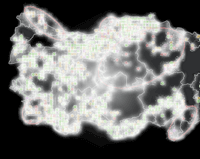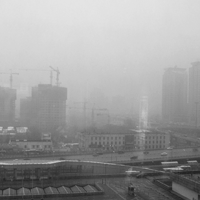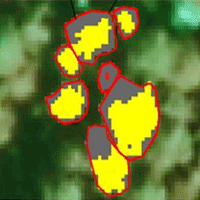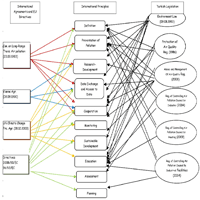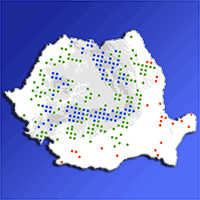
Monitoring the effects of air pollution on forest condition in Europe: is crown defoliation an adequate indicator?
iForest - Biogeosciences and Forestry, Volume 3, Issue 4, Pages 86-88 (2010)
doi: https://doi.org/10.3832/ifor0538-003
Published: Jul 15, 2010 - Copyright © 2010 SISEF
Review Papers
Collection/Special Issue: NFZ Summer School 2009 - Birmensdorf (Switzerland)
Long-term ecosystem research: understanding the present to shape the future
Guest Editors: Marcus Schaub (WSL, Switzerland)
Abstract
Forest condition in Europe is monitored under the International Co-operative Program on Assessment and Monitoring of Air Pollution Effects on Forests (ICP Forests). The focus of the program is to provide an overview of the status of forest ecosystems in Europe with respect to air pollution and contribute to the understanding of the relationship between pollution and forest health. Crown condition parameters, i.e., defoliation and discoloration, are used as the principal indicators of forest condition within the ICP Forest network. Crown condition assessments have been successful in disproving the “forest die-back” hypothesis. However, there are a number of limitations associated with this approach given the current monitoring objectives. Data from crown condition assessments indicate that stand age and country differences explain most of the variation in crown defoliation. It is difficult to clearly discern the effects of air pollution from other site and stress factors. The results do however indicate the role of meteorology and other factors. A better understanding of the relationships between forest condition and air pollution may be achieved if more specific, quantitative response variables are selected. However, we suggest that the original focus of the program on air pollution effects may need to be re-evaluated.
Keywords
Air pollution, Forest health, Monitoring, Crown condition, Defoliation
Authors’ Info
Authors’ address
Environmental and Life Sciences Program, 1600 West Bank Drive, K9J 7B8 Peterborough, Ontario (Canada)
Department of Plant Ecology, Albrecht von Haller Institute of Plant Sciences, Georg-August-Universität Göttingen, Untere Karspüle 2, D-37073 Göttingen (Germany)
Corresponding author
Paper Info
Citation
Johnson J, Jacob M (2010). Monitoring the effects of air pollution on forest condition in Europe: is crown defoliation an adequate indicator?. iForest 3: 86-88. - doi: 10.3832/ifor0538-003
Academic Editor
Marcus Schaub
Paper history
Received: May 25, 2010
Accepted: May 31, 2010
First online: Jul 15, 2010
Publication Date: Jul 15, 2010
Publication Time: 1.50 months
Copyright Information
© SISEF - The Italian Society of Silviculture and Forest Ecology 2010
Open Access
This article is distributed under the terms of the Creative Commons Attribution-Non Commercial 4.0 International (https://creativecommons.org/licenses/by-nc/4.0/), which permits unrestricted use, distribution, and reproduction in any medium, provided you give appropriate credit to the original author(s) and the source, provide a link to the Creative Commons license, and indicate if changes were made.
Web Metrics
Breakdown by View Type
Article Usage
Total Article Views: 49659
(from publication date up to now)
Breakdown by View Type
HTML Page Views: 42190
Abstract Page Views: 3011
PDF Downloads: 3579
Citation/Reference Downloads: 55
XML Downloads: 824
Web Metrics
Days since publication: 5035
Overall contacts: 49659
Avg. contacts per week: 69.04
Citation Metrics
Article Citations
Article citations are based on data periodically collected from the Clarivate Web of Science web site
(last update: Feb 2023)
Total number of cites (since 2010): 12
Average cites per year: 0.86
Publication Metrics
by Dimensions ©
Articles citing this article
List of the papers citing this article based on CrossRef Cited-by.
References
Intensive monitoring of forest ecosystems in Europe. Technical Report 2000, UNECE/EC, Geneva, Brussels, Belgium.
Gscholar
Intensive monitoring of forest ecosystems in Europe. 1. Objectives, set-up and evaluation strategy. Forest Ecology and Management 174: 77-95.
CrossRef | Gscholar
Neuartige Waldschäden? Ökologische Kritik an den Untersuchungsmethoden. Allgemeine Forstzeitschrift 796-797.
Gscholar
Vegetation Mitteleuropas mit den Alpen: In ökologischer, dynamischer und historischer Sicht. Ulmer, Stuttgart, Germany.
Gscholar
The condition of forests in Europe, 2002 executive report. UN/ECE, Geneva, Brussels, Belgium.
Gscholar
Forest condition in Europe, executive report. UNECE/EC, Geneva, Brussels.
Gscholar
Neuartige Waldschäden. In: Berlin-Brandenburgische Akademie der Wissenschaften, vol. 5, pp. 131-215.
Gscholar
Long-term ecosystem research: why monitoring is so important. In: “Long-term ecosystem research: understanding the present to shape the future” (Kaennel Dobbertin M ed). Zurich (Switzerland), 7-11 Sept 2009.
Gscholar
Forest health: its assessment and status. Commonwealth Agricultural Bureau, Wallingford, CT, USA.
Gscholar
Vierzehn Jahre Waldschadensdiskussion - Szenarien und Fakten. Naturwissenschaftliche Rundschau 11: 419-430.
Gscholar
Forest condition in Europe. 2003 Technical Report. UNECE/EC, Geneva, Brussels, Belgium.
Gscholar
Übersicht über den Stand der Waldschadensforschung unter besonderer Berücksichtigung bodenkundlicher Forschungsansätze. In: Die Entwicklung der Waldschäden (Weiß J-P ed). Wilhelm-Münker-Stiftung, Siegen, 30: 36-60.
Gscholar
Was macht eigentlich das Waldsterben? In: “Umweltgeschichte und Umweltzukunft - Zur gesellschaftlichen Relevanz einer jungen Disziplin” (Masius P, Sparenberg O, Sprenger J eds). Graduiertenkolleg Interdisziplinäre Umweltgeschichte, Universitätsverlag Göttingen, Germany.
Gscholar
Integrative studies on forest ecosystem conditions. Multivariate evaluations on tree crown condition for two areas with distinct deposition gradients. UNECE/EC, Geneva, Brussels.
Gscholar
Ökosystemare Wirkungsketten beim Wald- und Baumsterben. Forst- und Holzwirt 38: 468-474.
Gscholar
Ursachen des Waldsterbens in Mitteleuropa. Allgemeine Forstzeitschrift 45: 1365-1368.
Gscholar

